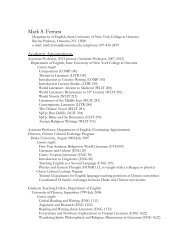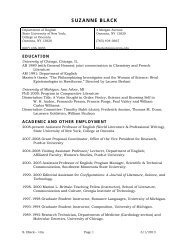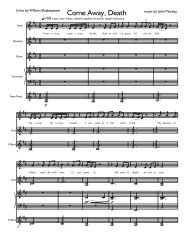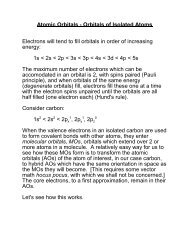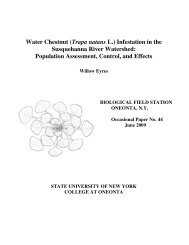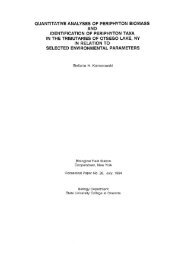Chapter 7 Electron Configurations and the Properties of Atoms 7.1 ...
Chapter 7 Electron Configurations and the Properties of Atoms 7.1 ...
Chapter 7 Electron Configurations and the Properties of Atoms 7.1 ...
You also want an ePaper? Increase the reach of your titles
YUMPU automatically turns print PDFs into web optimized ePapers that Google loves.
<strong>Chapter</strong> 7 <strong>Electron</strong>ic <strong>Configurations</strong> <strong>and</strong> <strong>the</strong> <strong>Properties</strong> <strong>of</strong> <strong>Atoms</strong><br />
most elements, <strong>and</strong> we can use electron configurations to predict physical <strong>and</strong> chemical properties <strong>of</strong><br />
<strong>the</strong> elements.<br />
Opening Exploration 7.3 <strong>Electron</strong> <strong>Configurations</strong><br />
7.3a The Pauli Exclusion Principle<br />
To predict <strong>the</strong> electron configuration for an atom’s ground state, <strong>the</strong> lowest energy state for an atom,<br />
electrons are put into <strong>the</strong> orbitals with <strong>the</strong> lowest energy possible, placing no more than two electrons<br />
in an orbital.<br />
The order <strong>of</strong> subshell filling is related to n, <strong>the</strong> principal quantum number, <strong>and</strong> , <strong>the</strong> angular<br />
momentum quantum number. In general,<br />
electrons fill orbitals in order <strong>of</strong> increasing (n + ) <strong>and</strong><br />
when two or more subshells have <strong>the</strong> same (n + ) value, electrons fill <strong>the</strong> orbital with <strong>the</strong><br />
lower n value.<br />
These general rules result in <strong>the</strong> following orbital filling order:<br />
1s, 2s, 2p, 3s, 3p, 4s, 3d, 4p, 5s, 4d, 5p, 6s, 4f, 5d, 6p, 7s, 5f, 6d, 7p, 8s, …<br />
The Pauli exclusion principle states that no two electrons within an atom can have <strong>the</strong> same set <strong>of</strong><br />
four quantum numbers (n, , ml, <strong>and</strong> ms). The limits on possible values for <strong>the</strong> four quantum numbers<br />
means that a single orbital can accommodate no more than two electrons, <strong>and</strong> when an orbital<br />
contains two electrons, those electrons must have opposite spins (Figure 7.3.1).<br />
Figure 7.3.1 Apply <strong>the</strong> Pauli Exclusion Principle<br />
<strong>Electron</strong> arrangements in an orbital that are (a) allowed <strong>and</strong> (b) not allowed<br />
- 6 -



